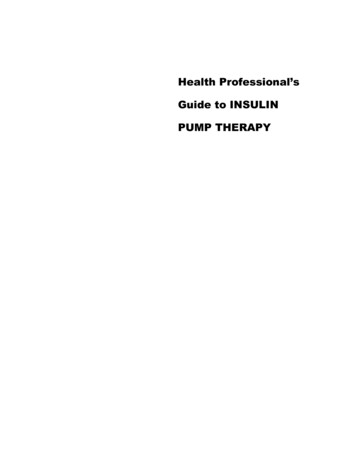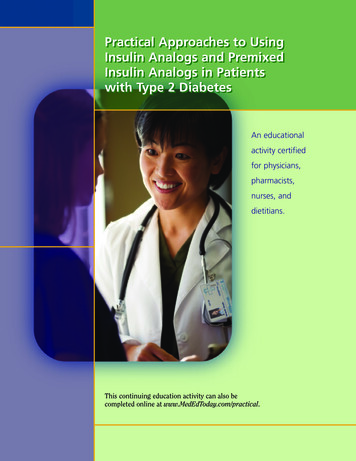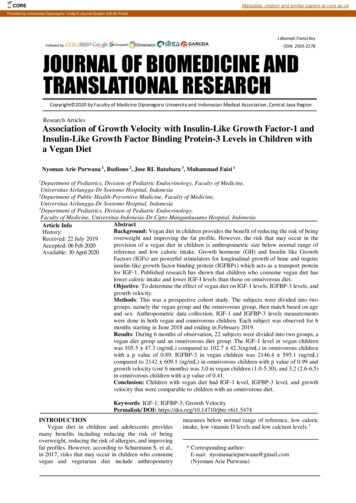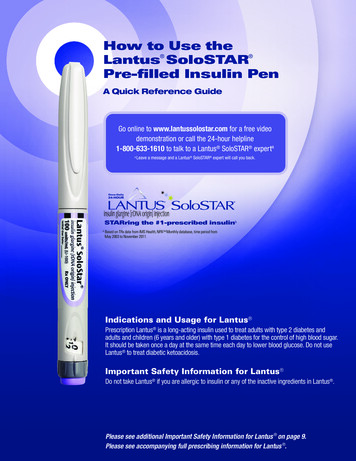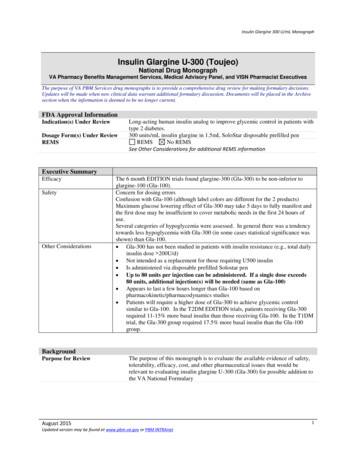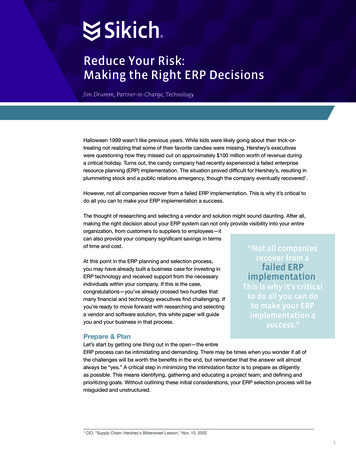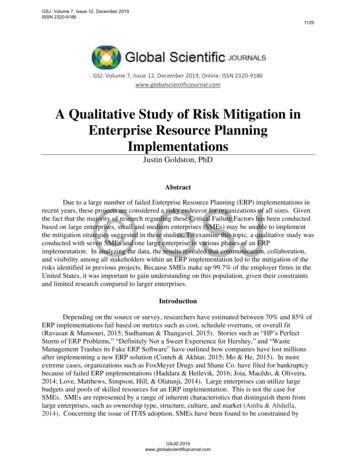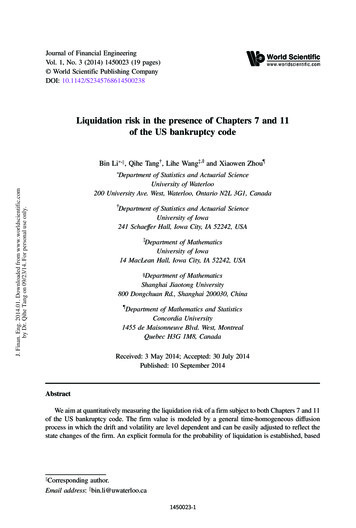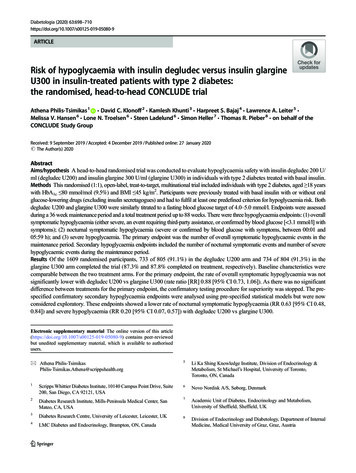
Transcription
Diabetologia (2020) 80-9ARTICLERisk of hypoglycaemia with insulin degludec versus insulin glargineU300 in insulin-treated patients with type 2 diabetes:the randomised, head-to-head CONCLUDE trialAthena Philis-Tsimikas 1 & David C. Klonoff 2 & Kamlesh Khunti 3 & Harpreet S. Bajaj 4 & Lawrence A. Leiter 5 &Melissa V. Hansen 6 & Lone N. Troelsen 6 & Steen Ladelund 6 & Simon Heller 7 & Thomas R. Pieber 8 & on behalf of theCONCLUDE Study GroupReceived: 9 September 2019 / Accepted: 4 December 2019 / Published online: 27 January 2020# The Author(s) 2020AbstractAims/hypothesis A head-to-head randomised trial was conducted to evaluate hypoglycaemia safety with insulin degludec 200 U/ml (degludec U200) and insulin glargine 300 U/ml (glargine U300) in individuals with type 2 diabetes treated with basal insulin.Methods This randomised (1:1), open-label, treat-to-target, multinational trial included individuals with type 2 diabetes, aged 18 yearswith HbA1c 80 mmol/mol (9.5%) and BMI 45 kg/m2. Participants were previously treated with basal insulin with or without oralglucose-lowering drugs (excluding insulin secretagogues) and had to fulfil at least one predefined criterion for hypoglycaemia risk. Bothdegludec U200 and glargine U300 were similarly titrated to a fasting blood glucose target of 4.0–5.0 mmol/l. Endpoints were assessedduring a 36 week maintenance period and a total treatment period up to 88 weeks. There were three hypoglycaemia endpoints: (1) overallsymptomatic hypoglycaemia (either severe, an event requiring third-party assistance, or confirmed by blood glucose [ 3.1 mmol/l] withsymptoms); (2) nocturnal symptomatic hypoglycaemia (severe or confirmed by blood glucose with symptoms, between 00:01 and05:59 h); and (3) severe hypoglycaemia. The primary endpoint was the number of overall symptomatic hypoglycaemic events in themaintenance period. Secondary hypoglycaemia endpoints included the number of nocturnal symptomatic events and number of severehypoglycaemic events during the maintenance period.Results Of the 1609 randomised participants, 733 of 805 (91.1%) in the degludec U200 arm and 734 of 804 (91.3%) in theglargine U300 arm completed the trial (87.3% and 87.8% completed on treatment, respectively). Baseline characteristics werecomparable between the two treatment arms. For the primary endpoint, the rate of overall symptomatic hypoglycaemia was notsignificantly lower with degludec U200 vs glargine U300 (rate ratio [RR] 0.88 [95% CI 0.73, 1.06]). As there was no significantdifference between treatments for the primary endpoint, the confirmatory testing procedure for superiority was stopped. The prespecified confirmatory secondary hypoglycaemia endpoints were analysed using pre-specified statistical models but were nowconsidered exploratory. These endpoints showed a lower rate of nocturnal symptomatic hypoglycaemia (RR 0.63 [95% CI 0.48,0.84]) and severe hypoglycaemia (RR 0.20 [95% CI 0.07, 0.57]) with degludec U200 vs glargine U300.Electronic supplementary material The online version of this ) contains peer-reviewedbut unedited supplementary material, which is available to authorisedusers.* Athena h.org5Li Ka Shing Knowledge Institute, Division of Endocrinology &Metabolism, St Michael’s Hospital, University of Toronto,Toronto, ON, Canada1Scripps Whittier Diabetes Institute, 10140 Campus Point Drive, Suite200, San Diego, CA 92121, USA6Novo Nordisk A/S, Søborg, Denmark2Diabetes Research Institute, Mills-Peninsula Medical Center, SanMateo, CA, USA7Academic Unit of Diabetes, Endocrinology and Metabolism,University of Sheffield, Sheffield, UK3Diabetes Research Centre, University of Leicester, Leicester, UK84LMC Diabetes and Endocrinology, Brampton, ON, CanadaDivision of Endocrinology and Diabetology, Department of InternalMedicine, Medical University of Graz, Graz, Austria
699Diabetologia (2020) 63:698–710Research in contextWhat is already known about this subject?xMinimising hypoglycaemia is important for people with type 2 diabetes using insulinxUse of second-generation long-acting basal insulins, insulin degludec 200 U/ml (degludec U200) and insulinglargine 300 U/ml (glargine U300), compared with insulin glargine 100 U/ml (glargine U100), has been shown toresult in a lower risk of hypoglycaemiaWhat is the key question?xIs there a difference in the risk of hypoglycaemia with degludec U200 compared with glargine U300 in insulintreated patients with type 2 diabetes when similarly titrated to a target fasting blood glucose of 4.0–5.0 mmol/l?What are the new findings?xThere was no significant difference in the rate of overall symptomatic hypoglycaemia with degludec U200 vsglargine U300 in the maintenance period in insulin-treated individualsxThe rates of nocturnal symptomatic and severe hypoglycaemia were nominally significantly lower with degludecU200 compared with glargine U300 during the maintenance periodHow might this impact on clinical practice in the foreseeable future?xResults from the CONCLUDE trial add to the published literature on the latest basal insulins, degludec U200 andglargine U300, informing healthcare providers and health systems on how to achieve blood glucose targets fortheir patients more safelyConclusions/interpretation There was no significant difference in the rate of overall symptomatic hypoglycaemia with degludecU200 vs glargine U300 in the maintenance period. The rates of nocturnal symptomatic and severe hypoglycaemia were nominally significantly lower with degludec U200 during the maintenance period compared with glargine U300.Trial registration ClinicalTrials.gov NCT03078478Funding This trial was funded by Novo Nordisk (Bagsvaerd, Denmark)Keywords Clinical science . Hypoglycaemia . Insulin degludec . Insulin glargine . Insulin therapyAbbreviationsDegludec U200FPGGlargine U100Glargine U300MMRMOADPYERRSMBGInsulin degludec 200 U/mlFasting plasma glucoseInsulin glargine 100 U/mlInsulin glargine 300 U/mlMixed model of repeated measuresOral glucose-lowering drugPerson-years of exposureRate ratioSelf-measured blood glucoseIntroductionHypoglycaemia is a known complication of insulin treatmentand is acknowledged as the main limiting factor for achievingtight glycaemic control [1, 2]. The two most recently developed second-generation, longer-acting basal insulins, insulindegludec and insulin glargine 300 U/ml (glargine U300), haveflatter and more stable steady-state pharmacokinetic and pharmacodynamic profiles compared with long-acting insulinglargine 100 U/ml (glargine U100) [3–6]. Insulin degludechas a lower day-to-day variability in glucose-lowering effectcompared with glargine U100 and glargine U300 [6, 7],whereas there are contradictory reports regarding within-dayvariability when comparing insulin degludec and glargineU300 [7, 8].Insulin degludec and glargine U300 have been shown to beassociated with a lower risk of hypoglycaemia, at equivalentglycaemic control compared with glargine U100 in individuals with type 2 diabetes [9–20]. Glargine U300 is a concentrated formulation of glargine U100 and has also been shownto be as effective as glargine U100 in terms of glycaemiccontrol in individuals with type 2 diabetes, but with a higher(12–14%) basal insulin dose requirement [14–20]. Recentresults in insulin-naive individuals with type 2 diabetesrevealed similar HbA1c reductions for insulin degludec andglargine U300 [21]. This trial also reported a similar overall
700risk of hypoglycaemia between the two insulins and a lowerrate of hypoglycaemia in the titration period with glargineU300 vs insulin degludec, while no evaluation of severehypoglycaemia was conducted as only one event was recorded during the trial. In addition, the dose of insulin degludecwas lower than the dose of glargine U300 at the end of the trialby 0.11 U/kg.The primary objective of the Trial Comparing the Efficacyand Safety of Insulin Degludec and Insulin Glargine 300Units/ml in Subjects with Type 2 Diabetes MellitusInadequately Treated with Basal Insulin and OralAntidiabetic Drugs (CONCLUDE), a randomised head-tohead clinical trial, was to investigate the effect of insulindegludec 200 U/ml (degludec U200) and glargine U300 onhypoglycaemia in insulin-treated individuals with type 2diabetes.MethodsTrial designDetailed methods of CONCLUDE have been described previously [22]. Briefly, this was a treat-to-target, randomised,open-label, active comparator-controlled trial that wasconducted at 229 sites in 11 countries. The original 58 weektrial duration comprised 52 weeks of active treatment withdesignation of the first 16 weeks as the titration period andthe remaining 36 weeks as the maintenance period (hereafterreferred to as the ‘variable maintenance period’). In February2018, a protocol amendment led to the extension of the trial,resulting in a total trial duration of up to 94 weeks with up to88 weeks of active treatment, including a new maintenanceperiod (hereafter referred to as the ‘maintenance period’) of36 weeks. A detailed rationale for this amendment has beenpublished previously [22] and the key reasons for the amendment are outlined in ESM Fig. 1. In brief, routine monitoringof blinded data showed an unusual pattern in the reporting ofglycaemic variables and hypoglycaemic events. Specifically,the glycaemic data were inconsistent between centrallaboratory-measured variables (HbA1c and fasting plasmaglucose [FPG]) and patient-reported fasting self-measuredblood glucose (SMBG) values. Data available from SMBGmonitoring indicated to the patient that the blood glucoselevels were higher than they actually were, potentially increasing the risk of hypoglycaemia as a result of unnecessary insulin up-titration. At the time of the amendment, the number ofpatient-reported hypoglycaemic events confirmed by bloodglucose was low while the number of pseudohypoglycaemic events (blood glucose 3.9 mmol/l withsymptoms) was high compared with the SWITCH 2 trial(comparing the effect of insulin degludec vs insulin glargineU100 on in individuals with type 2 diabetes) [10]. TheseDiabetologia (2020) 63:698–710observations, seen in general across the entire trial population,were related to the glycaemic data collection system(MyGlucoHealth blood glucose meter and electronic diary).Therefore, because of these safety concerns, the glycaemicdata collection system was discontinued during the variablemaintenance period. This system was replaced with an Abbottblood glucose meter and paper diary to be used for the remainder of the trial. To accommodate these changes, preserve thescientific integrity of the trial and ensure sufficient data collection for the confirmatory endpoints using the same glycaemicdata collection system (Abbott blood glucose meter and paperdiary), a new 36 week maintenance period was included in thetrial. At the time of the amendment, recruitment had beenfinalised and all participants on treatment had completed thetitration period. The duration of the variable maintenance period was dependent on each participant’s individualrandomisation date and/or approval of the amended protocolby health authorities and local ethics committees, if applicable. After implementation of the amended protocol, participants were asked to come in and initiate the maintenanceperiod as soon as the resources were available at the trial site,irrespective of the next planned visit. Thus, all participantswere not required to have all visits scheduled between weeks16 and 52. The trial data remained blinded at the point ofdiscovering the issue with the glycaemic data collectionsystem and the implementation of the protocol amendment.No unplanned interim analysis of the trial data from the titration period was conducted. The primary endpoint (number ofsevere or blood-glucose-confirmed symptomatichypoglycaemic events) at the completion of the maintenanceperiod was evaluated utilising the same analysis duration andstatistical methods as the original protocol. Changes wereimplemented to maintain participant safety and protect thescientific integrity of the trial.CONCLUDE is registered with ClinicalTrials.gov no.NCT03078478. The trial was conducted in accordance withthe Declaration of Helsinki and ICH Good Clinical PracticeGuideline [23, 24]. The protocol was approved byindependent ethics committees or institutional review boardsfor each centre; written informed consent was obtained fromeach participant before any trial-related activities.Participants and treatmentsEligible participants included adults aged 18 years with type 2diabetes with HbA1c 80 mmol/mol (9.5%), BMI 45 kg/m2and treated with basal insulin (once or twice daily; NPH insulin, insulin detemir, glargine U100) with or without oralglucose-lowering drugs (OADs) at stable doses (any combination of metformin, dipeptidyl peptidase-4 inhibitor, αglucosidase inhibitor, thiazolidinedione and sodium–glucosecotransporter 2 inhibitor) for at least 90 days. In addition,participants had to fulfil at least one risk criterion for
701Diabetologia (2020) 63:698–710hypoglycaemia [22]. The main exclusion criteria were treatment with bolus or premixed insulin or with sulfonylureas/glinides within 90 days before the screening visit, severe renalimpairment (eGFR 30 ml min 1 [1.73 m] 2), or impaired liverfunction (alanine aminotransferase or aspartate aminotransferase 2.5 times the upper limit of normal).Consenting participants were randomised using a trialspecific, interactive-voice, web-response system.Participants were randomised 1:1 to receive degludecU200 (Novo Nordisk, Bagsvaerd, Denmark; the 100 U/ml and 200 U/ml concentrations of degludec are bioequivalent and interchangeable [25–27]) or glargine U300(Sanofi, Paris, France) administered once daily. Withineach treatment arm, participants were randomised 1:1 toadminister basal insulin either in the morning (fromwaking to breakfast) or in the evening (from main eveningmeal to bedtime). The same dosing time was maintainedfor each participant throughout the trial. When initiatingdegludec U200, the pre-trial daily basal insulin dose wasreduced by 20%, as per the protocol, irrespective of priorinsulin type. Glargine U300 was initiated according to itslabel: unit-to-unit switch for participants on once-dailybasal insulin; 20% reduction for those on twice-dailyNPH insulin (US patients) or any twice-daily basal insulin(European and Canadian patients). The insulin dose wastitrated similarly for both insulins: once-weekly titrationwas based on the mean of three pre-breakfast SMBGmeasurements, with a fasting blood glucose target of4.0–5.0 mmol/l. The insulin dose was adjusted in multiples of 2 U ranging from 4 U to 8 U depending on themean pre-breakfast SMBG level [22]. The type and doseof pre-trial OADs remained unchanged throughout thetrial unless safety reasons required a change.EndpointsThe primary endpoint was the rate of overall symptomatic hypoglycaemic events (defined as severe [an eventrequiring third-party assistance [28]] or confirmed bloodglucose 3.1 mmol/l [with symptoms]) during the maintenance period. Secondary confirmatory hypoglycaemiaendpoints included the rate of nocturnal symptomatichypoglycaemic events (severe or blood-glucoseconfirmed with symptoms, occurring between 00:01and 05:59 h) and the rate of severe hypoglycaemicevents during the maintenance period. Overall symptomatic, nocturnal symptomatic and severe hypoglycaemicevents were also assessed during the total treatmentperiod (up to 88 weeks) as secondary endpoints. Othersecondary endpoints included change from baseline toend of treatment in HbA1c level and FPG level, basalinsulin dose at the end of treatment, pre-breakfastSMBG level and body weight. The composite endpointsHbA1c 53 mmol/mol (7.0%) with no overall symptomatic hypoglycaemia and HbA1c 53 mmol/mol (7.0%)with no nocturnal symptomatic hypoglycaemia wereassessed during the maintenance period. The numberof adverse events between the two treatment arms wasalso assessed during the trial period. An independentexternal event adjudication committee validated thefollowing selected adverse events in a blinded manner:fatal events and severe hypoglycaemia.Statistical analysisThe statistical analyses of the primary and secondaryendpoints have been described previously [22]. Endpointsrelated to hypoglycaemia and safety endpoints weresummarised using the safety analysis set; efficacy endpointswere summarised using the full analysis set. Statistical superiority testing of the primary and confirmatory secondaryendpoints was performed following a hierarchical testingprocedure to control the family-wise type I error rate in thestrong sense and has been described previously [22]. Thesample size was calculated to ensure at least 80% power forthe primary endpoint analysis.A negative binomial model with pre-trial OADs,region, sex and dosing time as fixed effects, age as covariate and logarithm of the exposure time as offset was usedto estimate the rate ratio (RR) of hypoglycaemic eventsduring the maintenance and total treatment periods.Participants with no on-treatment data during the maintenance period had values imputed for the maintenanceperiod analyses based on participants discontinuing treatment during the maintenance period. Multiple imputationswere performed using standard methods aligned with theanalyses and planned to create 1000 complete datasets.The results were then combined using Rubin’s methods[29]. The proportion of participants experiencinghypoglycaemic events was analysed post hoc using alogistic regression model. The model included treatment,pre-trial OADs, region, sex and dosing time as fixedeffects and age as a covariate, and logarithm of the exposure time as offset. Change from baseline to end of treatment in HbA 1c levels, FPG levels, SMBG and bodyweight were analysed post hoc using mixed models forrepeated measures (MMRM) with treatment, pre-trialOADs, region, sex and dosing time as fixed effects, andage and baseline HbA1c/FPG as covariates. Pre-specifiedsensitivity analyses were also conducted to test the primary and protocol-specified confirmatory secondaryhypoglycaemia endpoints without imputed data as wellas capping the number of hypoglycaemic events at three.Further post hoc sensitivity analyses controlling for variation across sites were conducted for HbA1c and FPG.
702Diabetologia (2020) 63:698–710ResultsParticipantsOf the 2008 eligible participants screened, 1609 wererandomised to receive either degludec U200 (n 805) orglargine U300 (n 804) (Fig. 1). A total of 1467 participants(91.2%) completed the trial of whom 1409 (87.6%) completedthe trial on treatment. The proportion of participants withdrawing from the trial and discontinuing treatment prematurely was similar for both treatment groups. The protocolamendment did not have an apparent impact on participantretention rates (Fig. 1).The characteristics of the participants at baseline were similar in the two treatment groups (Table 1) and did not differbetween the randomised population and those entering themaintenance period (ESM Table 1). The mean age was62.8 years, the mean duration of diabetes was 15.1 years,and the mean SD HbA1c level was 59.2 10.5 mmol/mol(7.6 1.0%). At screening, most participants were usingglargine U100 (65.0%) and were treated with metformin(77.5%).2008 Patients assessed for eligibility399 Excluded (ineligible)a278 Did not meet inclusion criteria134 Met exclusion criteria1609 Randomised805 (100.0%) Randomised to degludec U200403 Morning dose402 Evening dose802 Exposed804 (100.0%) Randomised to glargine U300402 Morning dose402 Evening dose798 Exposed57 Treatment discontinuation8 Adverse event7 Protocol deviation8 Lack of efficacy34 Other43 Withdrawn from trialb36 Withdrawal by patient4 Lost to follow-up3 Death0 Not collected60 Treatment discontinuation13 Adverse event7 Pr
U200 vs glargine U300 in the maintenance period. The rates of nocturnal symptomatic and severe hypoglycaemia were nomi-nally significantly lower with degludec U200 during the maintenance period compared with glargine U300. Trial registration ClinicalTrials.gov NCT03078478 Funding This trial was funded by Novo Nordisk (Bagsvaerd, Denmark)Cited by: 15Publish Year: 2020Author: Athena Philis-Tsimikas, David C. Klonoff, Kamlesh Khunti, Harpreet S.
